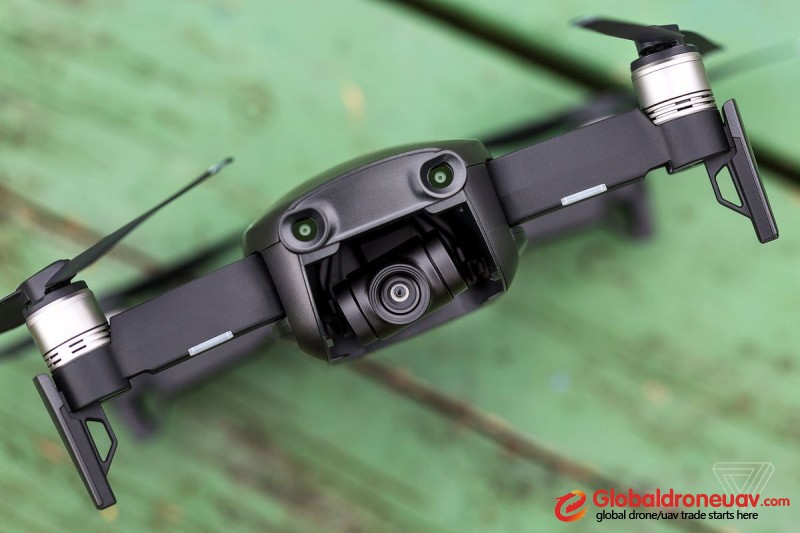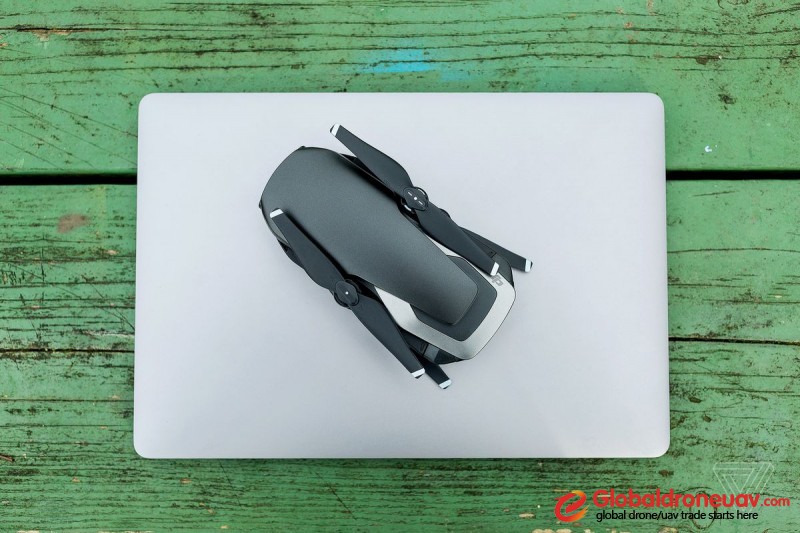
DEPTH REVIEW:DJI MAVIC AIR-A PORTABLE PHOTOGRAPHER
For a photographer or a videographer, the amount of gear they’re able to bring on a shoot is often limited to what can fit in their bag. As a video director for The Verge, my large bag is loaded with multiple cameras, lenses, batteries, tripods, mounts, and other accessories. That means I often have to leave my old Phantom 3 drone behind, which also means that I leave behind the opportunity to get great aerial shots. With DJI’s new Mavic Air, I don’t have to make those compromises anymore.
The new $799 Mavic Air shares a lot of similarities with both the DJI Spark and the Mavic Pro and Pro Platinum. Like those models, it’s a compact drone with a 12-megapixel camera and a handful of different flying and shooting modes. It’s not targeted toward professionals, but rather hobbyists or enthusiasts who might be buying their first drone for aerial photography and videography and aren’t satisfied with the Spark’s limited creative options. The Air also has a couple of new tricks, like new obstacle avoidance technology.
Though it’s not necessarily being sold as a pro camera drone, I wanted to see if the Mavic Air could be suitable for more serious photo and video work. Sadly, it’s not quite up to snuff for demanding droneographers, but that doesn’t mean it’s not a great drone.
Before we talk about what it’s like to fly the Air and shoot, there are a few design details to go through. I can’t believe I am going to say this about a drone, but this product looks great. In general, drones aren’t something you associate with good design; they tend to look like oversized flying bugs. In contrast, the Air is surprisingly sleek. It has nice materials, attractive colors, and a premium finish.
The defining feature of the Air is its portability. The entire package, from the drone itself, to its batteries, to its new remote are all designed for easy storage and transport. It’s by far the most portable drone in DJI’s lineup.
Some of the most clever design tweaks are found in the remote. The thumbsticks are now removable and can be stored under the arms that hold your phone. This makes it much easier to stow the remote in the Air’s included bag. (It took me a few minutes to find them the first time I flew the Air.) Oddly, charging the remote requires Micro USB, but the drone itself has a USB Type-C port to transfer footage. It doesn’t make sense that two different USB cables are needed.

The Air is also very sturdy. The foldable legs snap nicely into place, though sometimes you have to force the propeller over the leg, which can feel odd. Unlike the Mavic Pro, where the gimbal was exposed, the Air hides the 3-axis gimbal in the body of the drone itself. It’s those kinds of changes that make it much easier to travel with.
Unfortunately, the Air’s camera, which is rapidly becoming the most important component of any drone, didn’t blow me away. It shares the same small sensor as the Spark and the Mavic Pro and Pro Platinum, which means it has limited ability to capture a full range of bright and dark tones in a single scene. It does offer a slight bump in video quality, at least on paper: the Air shoots 4K videos at 30 fps with a 100 Mbps bitrate, compared to Pro’s 4K footage at 60 Mbps. The 3-axis gimbal is the same as found on the Mavic Pro, and it’s better than the simpler, 2-axis gimbal used on the Spark. For stills, it captures the same 12 megapixels as the others.
One thing to consider, though, especially if you’re doing commercial photography, is that the image sensor in the Air is smaller than the one you’d find in the Phantom 4 Pro. And the difference is noticeable. If you’re really, really serious about dronography, you may want to skip the Mavic line entirely for this reason.
Flying the Air can be done one of three ways. The most common way is what DJI calls the “wired connection,” using the bundled remote coupled with your phone. It’s a bit of a misnomer because there are no actual wires being used here. Then there’s the “wireless connection,” which relies entirely on your phone. The final mode is a hands-free gesture control system, which is available on both the Spark and Mavic Pro. In my tests, gestures work just as well as they did in previous models. They’re fairly responsive, and yes, it does make you feel like a Jedi. Still, as a videographer, you’ll rarely find any use for them since the camera needs to be facing you for them to work.
The controller looks similar to the one you get with the Pro — except it lacks a display, and the thumbsticks need to be attached before you can fly. It also lacks the second dial where you can adjust the exposure, which made it more complicated to adjust my exposure settings when flying.
INITIAL PAIRING ISSUES GAVE ME A FEW HEADACHES BEFORE I COULD EVEN FLY
I initially had some difficulties getting the Air paired to my phone. (My phone kept wanting to jump to my home network.) once it was paired, each time I had to use the drone again, I had to re-pair the device again, which obviously got annoying quickly. DJI suggested waiting for the green lights on both the remote and the drone to light up, before launching the app, which did the trick for the most part. I’d still occasionally get errors regarding the compass, but usually a quick reset would fix the issue.
Another major distinction between the old Mavic Pro and the Air is that Air relies on a Wi-Fi connection rather than radio frequency, or RF. Some might not welcome that change, but in my testing, it really hasn’t been an issue aside from the initial pairing. The big trade-off is a loss of range, but the best practice for drone flying is not to go outside of your line of sight, which keeps you much closer than the range limit. Still, there are pilots that have seen the Air fly only half of its already-reduced promised range.
The Mavic Air’s big new tech feature is a flying assist mode called APAS, short for Advanced Pilot Assistance System. All of the previous DJI drones have relied on basic obstacle avoidance, which tries to prevent them from crashing into trees, walls, and other objects. The difference is that APAS actually lets it fly over or around objects, instead of just coming to a stop. In my testing, this has worked very well. I tried flying it into a tree and toward myself multiple times, and each time the drone would steer away and bypass objects. It fails elegantly, as well: if its reading of the area is bad, the drone will just hover in place.
THE AIR’S VIDEO QUALITY IS onLY A MINOR STEP UP FROM THE MAVIC PRO
Perhaps the most important thing for a droneographer is the footage they can capture, and for the most part, the Air’s looks fine. It’s a minor step up from the Pro Platinum, so upgrading from that model likely isn’t worth it. The difference in bitrate is not something you’ll notice without reviewing the footage on larger screens. Still, the bump in bitrate does provide more data to work with in post-production. The biggest issue with smaller sensors is their limited dynamic range, and the Air’s increased bitrate doesn’t solve this problem.
When you’re shooting during the daylight, everything looks sharp and rich. But once you introduce a scene with high contrast, like a sunrise, the image starts to fall apart. In lower light, shadow areas have a lot of noise and lose all their detail. This happens even when shooting in the Cinelike color profile, which provides more flexibility to manipulate exposure while editing.
Still photos have similar issues, but the Air’s ability to shoot RAW files gives me much more flexibility when processing them after the fact, so it’s less of a problem.
I typically fly drones in manual mode, because it gives me the most control over the shots I’m capturing. But there is one automatic flying mode that I’m obsessed with, and it’s called “Asteroid.” In this mode, the drone identifies and focuses on you, flies backward and up in the air where it hovers for about a minute, and takes a spherical 360 shot. The app then automatically stitches the video and photos into a single clip. It’s a wild effect that’s fun to use for intros or outros of a video.
You can also take spherical 360 photos, which look great, but the only way you can display them is on your phone via the DJI Go app. The app does all the stitching for you, but individual photos are also saved on your card in case you want to stitch them yourself. And you might want to: a few times the automatic stitching produced some weird ghosting effects.
Given the Air’s compact size, its performance in wind could be a concern. We haven’t had a truly windy day in San Francisco during my test period, but I did get the strong wind alert when I didn’t really think there was a need for one.
Finally, the battery life. DJI markets the flight time as 21 minutes, and, for the most part, that’s what you’ll get on a full charge. But the actual time you have to capture footage is going to be noticeably less than that. By the time you get it up in the air, plus the time to bring it back for landing, you’re looking at about 15 minutes of flight time. The basic Air kit only comes with one battery, which makes the shorter flight time even more constrictive. DJI also offers a $999 option that adds two more batteries and a handful of other accessories over the standard kit.
The Mavic Air really is the best of both worlds offered by the Mavic Pro and the Spark. It has a slightly improved camera inside a smaller body than either the Pro or Spark. It likely still won’t satisfy those that need something for commercial work — that’s better served by DJI’s Phantom or Inspire line — but for the rest of us, the Mavic Air is the drone to beat.
